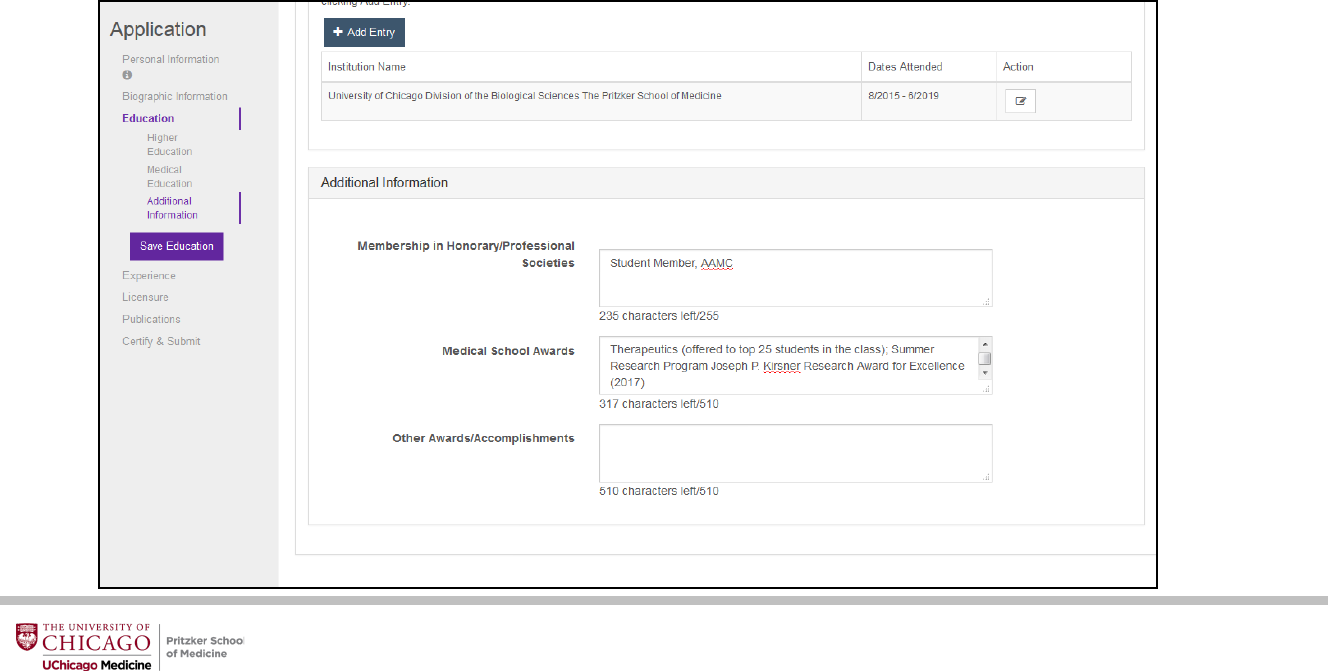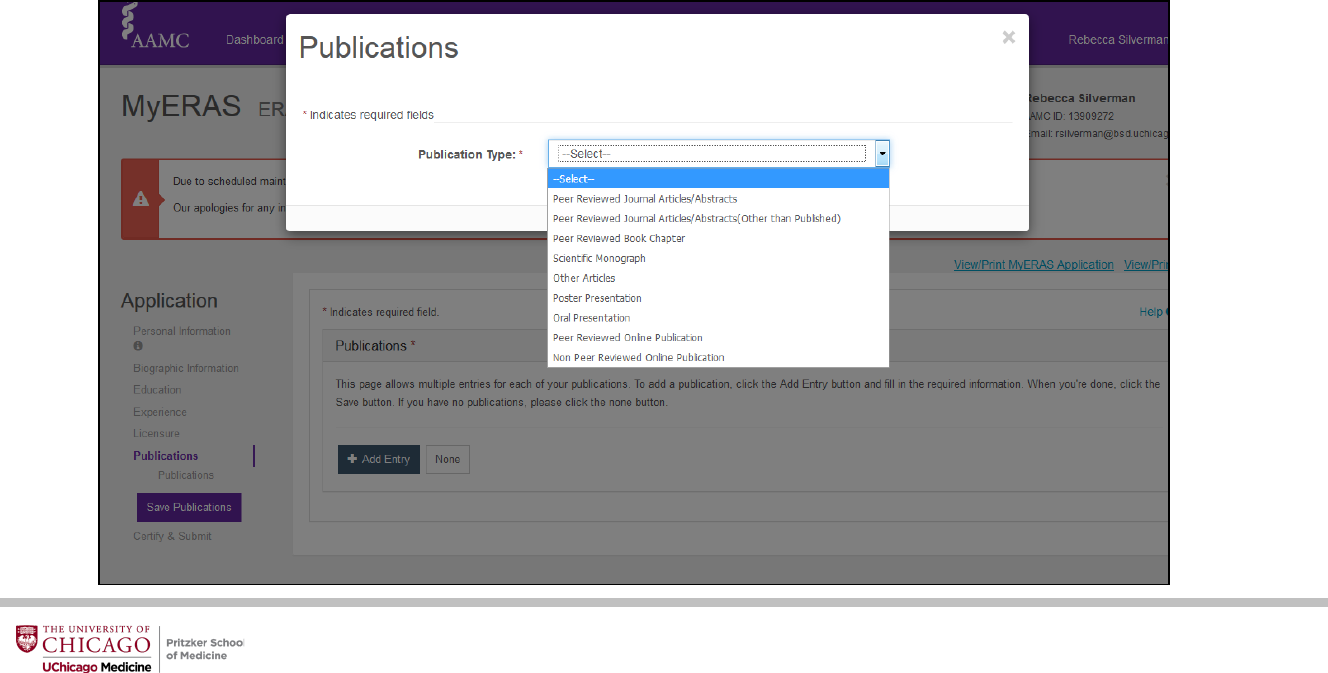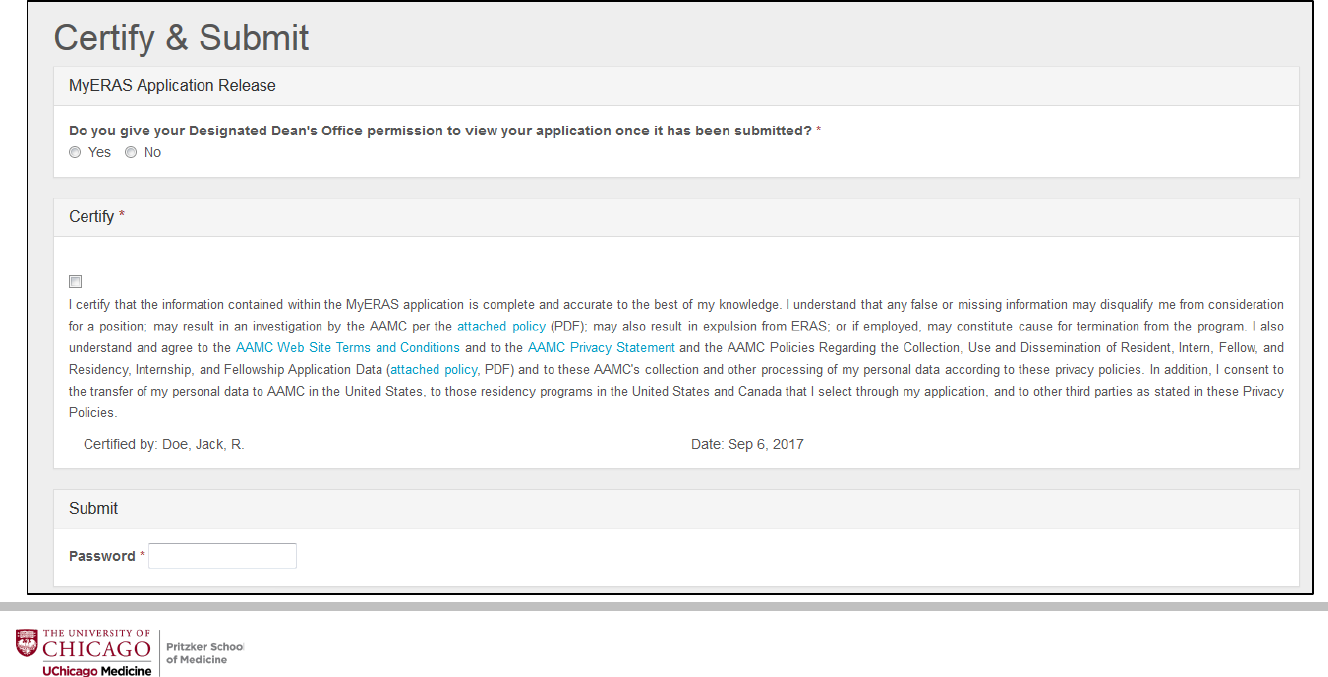
ERAS Overview
MS4 Class Meeting #2
July 8, 2019
The Electronic Residency Application Service

ERAS Overview
Agenda
• Review of MS4 Class Meeting #1
• Navigating ERAS
• Identifying and Applying to Programs within ERAS
3

Review
4

Timeline Review: July - August
July – August Organize CV (follow template)
Meet with Dr. Fromme, if you have not already done so
Ask for Letters of Recommendation
Sign up for your ERAS/Graduation photo
Prepare for and submit your SVI (EM students only)
Write your Personal Statement
Send a draft to your career and specialty advisors for review
Edit your ERAS application to near completion
This timeline is designed for students applying through the regular match.
5

Timeline Review: August – Early September
August – early September MSPE Review
Continue to edit your ERAS application and
Personal Statement
LORs uploaded
6

Timeline Review: September 5-15
September 5 Beginning of the 10-day period where you can certify
and submit your ERAS application
(Programs will NOT receive apps before 9/15)
September 15 Programs begin receiving applications
NRMP Registration opens
(You must register for both ERAS and the NRMP)
7

Timeline: October - December
October 1 MSPEs are released to programs
November 30 Deadline for NRMP registration
December 1 PSOM Step 2 test date deadline
8
Review

LORs: How many letters do I need?
Categorical Programs: 3-4 total letters
• 3 clinical letters
• 1 research letter (if appropriate)
Note: You cannot submit more than 4 letters to a single program.
Advanced Programs: 6-7 total letters
• Prelim/Transitional Year: 3 clinical letters
• Advanced Program: 3 clinical letters
1 research letter (if appropriate)
Note: Letter writers can use the same letter for both applications, as long as they are generic in their specialty
recommendation.
(i.e. “I recommend John Doe for your residency program” instead of “I recommend John Doe for your Pediatric residency
program”)
9
Review

LORs: Do I need a Chair’s Letter?
• Anesthesiology
• Medicine*
• Medicine-Pediatrics*
• Preliminary Medicine*
• Obstetrics and Gynecology
• Orthopedic Surgery
• Otolaryngology (Section Chief)
• Pediatrics (some programs)*
• Plastic Surgery (Section Chief)
• Surgery
• Urology (Section Chief)
*Another faculty member writes the letter in conjunction with the Chair.
Emergency Medicine utilizes a “Standardized Letter of Recommendation”, and Plastic Surgery is starting to do the same. Check with
the section for details, and refer to your Residency Process Booklet.
If you are applying in both Preliminary Medicine and transitional programs, you could use the same set of letters for both if the
letters are generic in their specialty designation.
10
Review

Important Staff
Strategy/LoRs Career Advisor
Specialty Advisor
Dr. Woodruff
Personal Statement Career Advisor
Specialty Advisor
MSPE/Grade Concerns Dr. Fromme
Couples’ Matching Career Advisor
Dr. Woodruff
CV/ERAS Logistics Rebecca Silverman
11
Review

Navigating ERAS:
The Electronic Residency Application Service
12

Definitions
ERAS The Electronic Residency Application Service
ERAS is the web-based program students and staff use to
compile and distribute residency application components.
NRMP The National Resident Matching Program
The NRMP is a nationwide non-profit organization that
standardizes the residency matching process. Students
submit rank lists to NRMP, not through ERAS.
You must register for both ERAS and the NRMP!
13
ERAS

Register
14
ERAS

MyERAS Dashboard
15
ERAS

Application
16

ERAS Personal Information
17
ERAS

ERAS Personal Information (continued)
18
ERAS

ERAS Personal Information (continued)
19
ERAS

Biographic Information—Optional
20
ERAS

Biographic Information (continued)
21
ERAS

Education
22
ERAS

Adding a Post-Baccalaureate
23

Education (continued)
24
ERAS

Experience
25
ERAS

Experience: Adding an Entry (Work Experience)
26
ERAS

Experience: Adding an Entry (Research Experience)
27
ERAS

Experience: Adding an Entry (Volunteer Experience)
28
ERAS

Experience: Adding an Entry (Volunteer Experience #2)
29
ERAS

Experience: Adding an Entry (Volunteer Experience #3)
30
ERAS

Experience: Final Screen
31

Licensure: Not Necessary
32

Publications
33
ERAS

Publications (continued)
34

Publications (continued)
35

Guiding Principles for Listing Publications
• Be honest in representing all of your myriad accomplishments—but do not try to pad your
application
– Certain situations will require that you list things twice under two separate categories
– Use your best judgement, and then…
– Consult your Career Advisor!
• When it is not reasonable to list multiple similar or identical publications/presentations, list
them once under their “highest value”. In order, that is:
1. Manuscript
2. Published abstract
3. Oral presentation
4. Poster presentation
• National > Regional > Local
36

FAQs: How to List Publications
Q: For poster presentations, should we list internal conferences like Medical Education Day or
SRP?
A: Yes. Include poster presentations given at any formal, organized event, even if they
are internal.
Q: If I was listed as an author on a poster or oral presentation but did not present it, should I list
it?
A: Yes, you may include it as a poster; annotate who the presenting author was with an
asterisk in the author line, or in a description box. Make sure you list the authors in the correct
order.
Q: If I am going to do an oral presentation in a month, do I put "anticipated" oral presentations?
A: Yes, you may do that.
37

FAQs: How to List Publications (continued)
Q: Does my thesis defense count as an oral presentation?
A: No, it does not count as a separate oral presentation. It will be implied by your PhD.
Q: Do presentations in front of my departments or during rounds count?
A: No.
Q: Are abstracts considered published if they are published in a conference booklet only?
A: No, abstracts are not considered published if they are not disseminated beyond the conference.
If they were a poster, though, you may put it in the poster section. Do not list things twice (i.e. once in a
poster section and once in an abstract section—just list the abstract).
Q: Can I list manuscripts currently in preparation?
A: No. However, if they have been submitted, you can choose submitted from the drop-down in
ERAS. Be prepared to answer any questions about the status of the manuscripts.
38

View/Print ERAS Application or CV for Proofreading
39

Documents
40

Documents: Personal Statements
41
ERAS

Documents: Personal Statements (Continued)
42
ERAS

Personal Statement Preview
43

Documents: Personal Statements (Continued)
44
ERAS

Documents: LORs
45
ERAS

Documents: LORs (continued)
46
ERAS

Documents: LORs (continued)
47

Documents: LORs (continued) | Confirm your LOR
48

Documents: LORs (continued) | Generate Letter Request Form
49

Documents: LORs (continued) | Email a Letter Request Form
50

Documents: LORs (continued) | Email a Letter Request Form
51

Documents: LORs (continued) | Generate a PDF Letter Request Form
52

Additional Documents
53
ERAS
• Student
• PSOM (by 10/1)
• PSOM
• Student

USMLE Transcripts
Three steps to releasing your scores:
1. Authorize release through ERAS to sync current scores
2. Assign the USMLE score to a specific program (under the Programs section)
3. Once you receive updated Step 2 scores, go back into MyERAS and
retransmit your scores
– Think strategically about when or whether you want to release your Step 2
scores—discuss this with your Career Advisor or Dr. Woodruff.
54
ERAS

Programs
55

AAMC Apply Smart data
56
https://students-residents.aamc.org/applying-residency/article/apply-smart-data-consider/

NRMP Residency Explorer
57

When using the Apply Smart data, remember…
• No advice is one-size-fits-all.
• You may receive different advice from different advisors or mentors.
– This is a complex process with multiple possible approaches and a high degree of
uncertainty.
– This happens all the time in life, not just in residency advising!
• Use all data and advice at your disposal to make the best decisions for you.
58

Programs (searching by number)
59
ERAS
This is an NRMP ID, not an Accreditation ID. If you are looking up a program by number and
not finding it, it’s likely to be an NRMP ID. We recommend searching by specialty instead.

Programs (searching by specialty)
60

Saving Programs
61

Assigning Documents in “Saved Programs”
62

Assigning Documents
63

Assigning Documents
• If you do not see an LOR listed, you probably did not
“confirm” it in the LOR section.
• You cannot assign an LOR until it has been uploaded.
• Only YOU can see how you’ve titled the LORs, so make
sure they are clearly labeled.
64

Assignment Report
65

Fees
66

2019-20 ERAS Fees
Base Fee, 1-10 applications $99
Applications 11-20 $15 each
Applications 21-30 $19 each
Applications > 31 $26 each
USMLE Transcript Fee $80
• Example 1
– 30 Emergency Medicine programs: [$99.00 + (10 x $15.00) + (10 x $19.00)] = $439
• Example 2
– 20 OB/GYN programs [$99.00 + (10 X $15.00)] + 10 Family Medicine programs [$99.00] = $348
67

2019-20 NRMP Fees
Base Fee $85 for 20 ranks
Late registration fee $50 if you register after November 30
Couples $25 per partner
Additional Programs $30 for every program ranked above 20 ranks
From the NRMP: The NRMP also has capped at 300 the number of ranks allowed for individual applicants and applicants
participating in the Match as a couple. In addition… there will be a new Length of Rank Order List Fee. Lists with 100 or
more ranks will incur stepped fees, up to a maximum of $200 until the 300 rank cap is reached. These changes are being
made to prevent applicants from entering over-long ROLs, some of which have exceeded 700 ranks without any apparent
benefit to the applicants’ Match outcome.
68

Pritzker 2018-19 Data
Data from our annual post-Match survey
9. How much money do you estimate that you spent applying and interviewing during the
residency application season (including application, travel, and hotel costs)? Please round
to the nearest $10.
Richard in Financial Aid is here to work with you to help with these costs.
Also, look out for info on our free alumni hosting program when traveling for interviews!
69
Statistic Value
Mean $3,358
Median $2,825
Mode $3,000
Standard Deviation $2,533
Valid Responses 62
Total Responses 62

Certify and Submit
70

Certify and Submit
71

Certify & Submit
72
ERAS

Adding Programs After September 15
You can add programs after you have submitted your
ERAS application,
but you must re-assign your USMLE scores and photo
73

Top 5 ERAS Points
1. Hit “Save” all of the time, and proofread.
– View your ERAS application in both CV and “application” formats
– Print your Assignment Report and make sure you assigned all your documents
2. Remember to click the final “Certify and Submit” button between September 5-15, and
have your credit card ready! (We will send a reminder. Many reminders.)
3. Be deliberate when naming and assigning your letters and personal statements.
4. Track the status of your LORs and assign LORs to programs once they arrive.
5. You can add programs after Sept. 15, but be sure to re-assign your documents and
USMLE scores.
74

Upcoming Class Meetings
September 25 MS4 Class Meeting #3: Interviewing for Residency
January 22, 2020 MS4 Class Meeting #4: Preparing your Rank List
March 20, 2020 Match Day!
75
